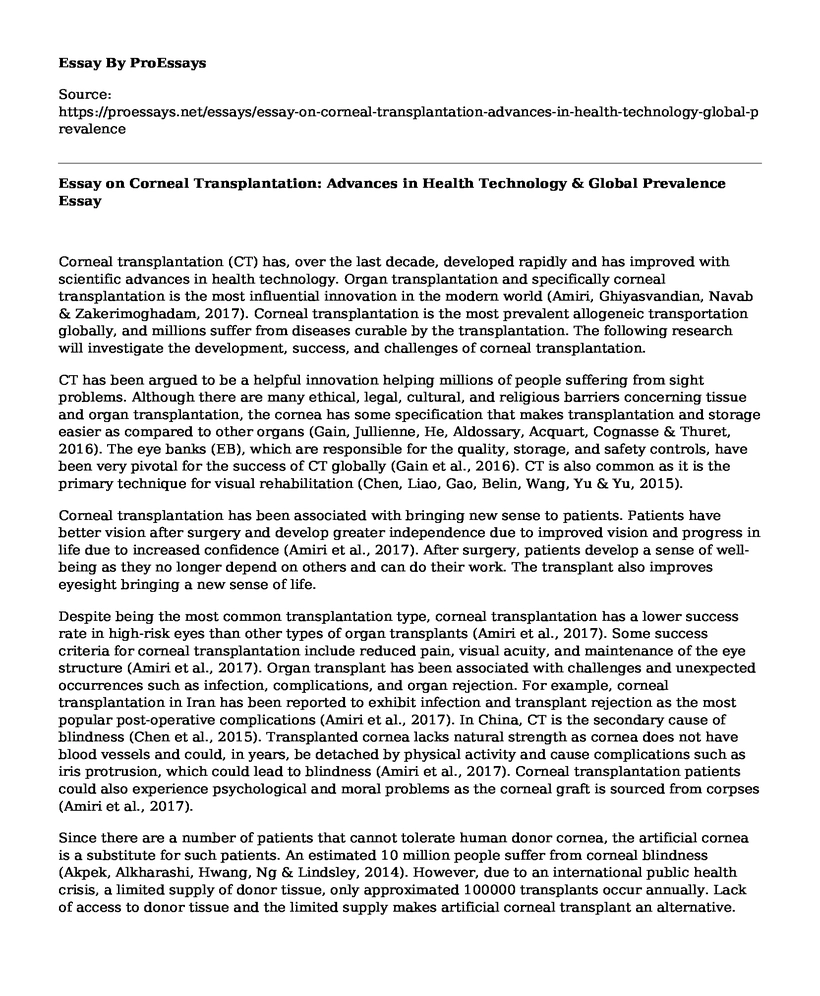Corneal transplantation (CT) has, over the last decade, developed rapidly and has improved with scientific advances in health technology. Organ transplantation and specifically corneal transplantation is the most influential innovation in the modern world (Amiri, Ghiyasvandian, Navab & Zakerimoghadam, 2017). Corneal transplantation is the most prevalent allogeneic transportation globally, and millions suffer from diseases curable by the transplantation. The following research will investigate the development, success, and challenges of corneal transplantation.
CT has been argued to be a helpful innovation helping millions of people suffering from sight problems. Although there are many ethical, legal, cultural, and religious barriers concerning tissue and organ transplantation, the cornea has some specification that makes transplantation and storage easier as compared to other organs (Gain, Jullienne, He, Aldossary, Acquart, Cognasse & Thuret, 2016). The eye banks (EB), which are responsible for the quality, storage, and safety controls, have been very pivotal for the success of CT globally (Gain et al., 2016). CT is also common as it is the primary technique for visual rehabilitation (Chen, Liao, Gao, Belin, Wang, Yu & Yu, 2015).
Corneal transplantation has been associated with bringing new sense to patients. Patients have better vision after surgery and develop greater independence due to improved vision and progress in life due to increased confidence (Amiri et al., 2017). After surgery, patients develop a sense of well-being as they no longer depend on others and can do their work. The transplant also improves eyesight bringing a new sense of life.
Despite being the most common transplantation type, corneal transplantation has a lower success rate in high-risk eyes than other types of organ transplants (Amiri et al., 2017). Some success criteria for corneal transplantation include reduced pain, visual acuity, and maintenance of the eye structure (Amiri et al., 2017). Organ transplant has been associated with challenges and unexpected occurrences such as infection, complications, and organ rejection. For example, corneal transplantation in Iran has been reported to exhibit infection and transplant rejection as the most popular post-operative complications (Amiri et al., 2017). In China, CT is the secondary cause of blindness (Chen et al., 2015). Transplanted cornea lacks natural strength as cornea does not have blood vessels and could, in years, be detached by physical activity and cause complications such as iris protrusion, which could lead to blindness (Amiri et al., 2017). Corneal transplantation patients could also experience psychological and moral problems as the corneal graft is sourced from corpses (Amiri et al., 2017).
Since there are a number of patients that cannot tolerate human donor cornea, the artificial cornea is a substitute for such patients. An estimated 10 million people suffer from corneal blindness (Akpek, Alkharashi, Hwang, Ng & Lindsley, 2014). However, due to an international public health crisis, a limited supply of donor tissue, only approximated 100000 transplants occur annually. Lack of access to donor tissue and the limited supply makes artificial corneal transplant an alternative.
Conclusion
In conclusion, corneal transplantation creates a new sense of life for patients. However, there are serious challenges and issues associated with the transplant, including a sense of fear and fear for the future blindness. As such, problems associated with corneal transplantation continue to be an endless, sensitive, and continuous subject with the rapid change and development in medical technology. Nurses and other health professionals need to assist patients and create awareness to encounter emerging issues that may affect the patients.
References
Akpek, E. K., Alkharashi, M., Hwang, F. S., Ng, S. M., & Lindsley, K. (2014). Artificial corneas versus donor corneas for repeat corneal transplants. Cochrane Database of Systematic Reviews. https://doi.org/10.1002/14651858.cd009561.pub2
Amiri, F., Ghiyasvandian, S., Navab, E., & Zakerimoghadam, M. (2017). Corneal transplantation: A new view of life. Electronic physician, 9(4), 4055-4063. https://doi.org/10.19082/4055
Chen, Y., Liao, C., Gao, M., Belin, M. W., Wang, M., Yu, H., & Yu, J. (2015). Efficacy and Safety of Corneal Transplantation Using Corneas from Foreign Donors versus Domestic Donors: A Prospective, Randomized, Controlled Trial. Journal of Ophthalmology, 2015, 1-10. https://doi.org/10.1155/2015/178289
Gain, P., Jullienne, R., He, Z., Aldossary, M., Acquart, S., Cognasse, F., & Thuret, G. (2016). Global Survey of Corneal Transplantation and Eye Banking. JAMA Ophthalmology, 134(2), 167. https://doi.org/10.1001/jamaophthalmol.2015.4776
Cite this page
Essay on Corneal Transplantation: Advances in Health Technology & Global Prevalence. (2023, Apr 08). Retrieved from https://proessays.net/essays/essay-on-corneal-transplantation-advances-in-health-technology-global-prevalence
If you are the original author of this essay and no longer wish to have it published on the ProEssays website, please click below to request its removal:
- Research Paper on Digital Wallets
- EBP and PICOT Essay
- Dementia Prevention Among the Elderly Paper Example
- Struggles Between Anti-Vaccine Parents and Pro-Vaccine Parents
- Research Paper on Listerine: Killing Bacteria for Healthy Gums & Breath
- Essay Example on Group Dynamics: Exploring Support & Prevention Groups
- Imogene King's KCS: Open Systems Theory for Nurses - Essay Sample







